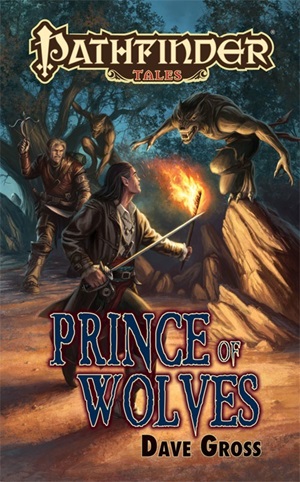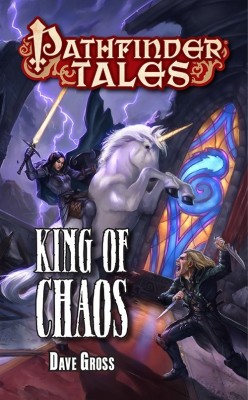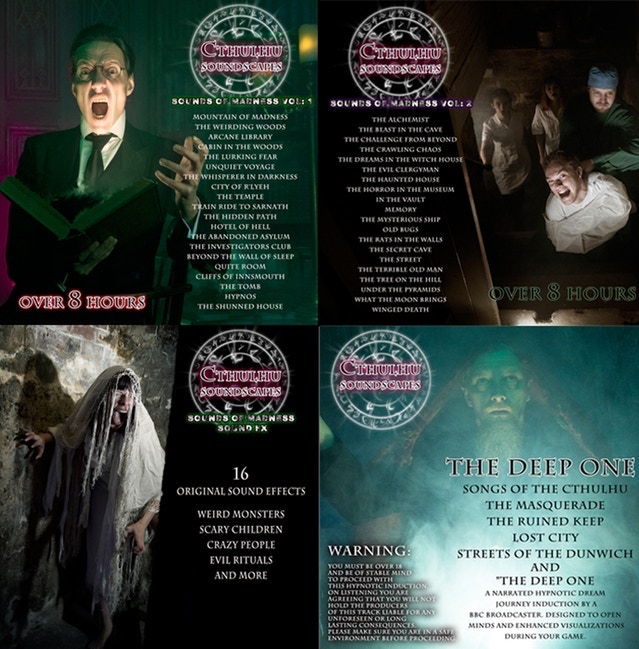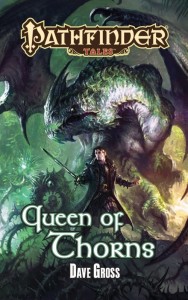Check out the first part of this interview at paizo.com.
How much leeway do you have for sweeping world changes? How “big” can you get without needing to check in with editorial?
Virtually none, and not big at all.
I can propose anything I like, but if it involves the death of an important campaign figure, a change in government, or even the appearance of certain powerful beings, the answer will almost always be “no.”
That said, I do occasionally propose biggish things and get approval on some of it. And I think in future, as the campaign setting progresses, they may tap novelists to write stories set during big events.

What was one monster that you wanted to have in there that you just couldn’t fit or had to edit out of Prince of Wolves?
You know, I don’t think there was one. I’m such a fan of gothic horror that I could write a dozen novels set in Ustalav, the way I could write a dozen novels set in Tian Xia, so there was never any impulse to cram in every possible trope and creature. You’ve got to leave some casting for later episodes.
However, months after finishing the novel, I realized that Prince of Wolves has several superficial similarities to one of my Forgotten Realms novels, Black Wolf. Among them were the presence of werewolves, a divine caster love interest, and an unorthodox vampire.
While I’ve nothing against the romantic version of the vampire, I’ve always preferred the monstrous aspects of the bloodsuckers. If those can be more viscerally horrifying than two neat puncture wounds on the neck, all the better.
Master of Devils: I think this one would make a hell of a comic, pun completely intended. If you had to pick a comic book artist and author to adapt it—and the guys doing the actual Pathfinder comic were busy—who’d you pick?
I would pick three different artists, one for each of the three POV characters’ stories.
For Radovan’s story, I’d pick Eduardo Risso. For Varian’s, Craig Russell. For Arnisant’s, Mark Nelson.
I can’t imagine who I’d choose to adapt my work. I’d much rather do it myself. But if the sky’s the limit and you put a gun to my head, I’d say Joss Whedon or one of his acolytes.
Queen of Thorns is all about genealogy, both Varian’s and Radovan’s. How far off the deep end have you gone with the family trees?
Not too far, but I have in mind the story behind Varian’s mother’s death, as well as the particular tragedies of several of Radovan’s ancestors, including his parents.
In my idea folder are a couple of flashback stories that could be revealed beside contemporary events. Several of them center on family matters.
King of Chaos: Okay Dave. You’ve just been made a Chaotic Evil Demon Prince, the whole package. What is your portfolio, what do you look like, and what is your level(s) of the Abyss like?
I’m full of phlegm today, so all I’ve got is “Demon Lord of Snot.”
Well, all right, if you were any demigod on any plane, what plane and what critter creature?
My celestial ambitions are modest. Put me in one with good alehouses that allow dogs.
Perhaps it’s the booster shot of Elysium, which we watched a few weeks ago, but I’ve no aspiration to live among the gods or the demons or any of those jerks. I’m a Prime Material boy.
Critters are all right, though. I like critters.
Okay, hot shot, pop quiz! Let’s have a soundtrack for each of your books.
My Ustalav Mix was full of Devotchka, Beirut, Gogol Bordello, Interpol, and Eivør Pálsdóttir, with occasional bursts of Lacuna Coil and Dream Theater and infrequent jolts of traditional Roma music.
Master of Devils folder started with the soundtracks for Crouching Tiger, Hidden Dragon; Hero; House of Flying Daggers; and Curse of the Yellow Flower and a little traditional mongolian, Japanese, and Chinese music. For Radovan’s chapters, I listened to a lot of Front Line Assembly, All That Remains, Alexisonfire, Bigelf, In Flames, Ivardensphere, Maylene and the Sons of Disaster, Taking Dawn, and assorted other metal.
I didn’t make a folder for Queen of Thorns, but I confess to breaking out some Enya, Clannad, Loreena McKennitt, and Mary Fahl when I didn’t feel sufficiently sylvan. To get in a demon mood, I sometimes broke out more metal or spooked myself with some Bill Laswell and Tetsuo Inoue or listened to Ligeti’s Requiem for as long as I could stand it without getting the shivers. I think there were days of nothing but trance and/or prog rock, too.
King of Chaos also didn’t have a dedicated folder, but I remember listening to Akira Ikufube’s Godzilla soundtrack, some Sigur Rós, Kenji Kawaii’s Ghost in the Shell soundtrack, Paul Ruskay’s haunting Homeworld soundtrack, and more of the above-mentioned metal and spooky stuff.
You recently had a Gencon panel with Elizabeth Vaughan, John Helfers, Lou Anders, and Brandon Sanderson on creating a system of magic and weaving the rules of a magic system into a story. You’ve inherited a Vancian magic system from the Pathfinder rules, but you’ve managed to find the knife edge of paradox; that is, you’ve gone “off the reservation” with Varian’s riffle scrolls & Radovan’s transformations, neither of which fits into a neat little box of class mechanics, but you’ve done so in such a way that their unique abilities & drawbacks still follow the cosmological mechanics of the world (and the game world). What are the pros and cons of this approach, and what do you think you have to learn from other writers in worlds with strong systems of the supernatural, like Sanderson?
Last question first: My sad confession is that I’m not up-to-date on what the current giants of fantasy fiction are doing. Most of my literary influences come from much earlier writers. I will remedy this failing over the winter, I promise!
In past work, I’ve sometimes offered characters who I felt were a little too “by the book.” Gradually I came to realize that what really makes an iconic fantasy protagonist is that he or she is an exception–not necessarily “the chosen one,” but a character who’s different from others. With that in mind, I sometimes push for a “house rules” approach to the game mechanics that provide the “magic physics” of the Pathfinder world.
But I don’t want to throw out the rules, of course. I just want to bend them sometimes, and never arbitrarily. For instance, even in the novella “Hell’s Pawns,” in which Count Varian Jeggare isn’t even a point-of-view character, I had a rationale for why he couldn’t cast spells like other wizards. I shared that reason with my editor, who generally approved of it, knowing that I wouldn’t reveal the truth until after I’d told a number of stories involving these characters. The time for the reveal–or most of it–came with King of Chaos. More of the rationale behind Count Jeggare’s unusual problem may unfold in later stories.
Likewise with Radovan’s unusual nature. I knew I wanted him to be different from other tief— I mean, hellspawn. “No horns, no tail” was the first rule I imposed on myself, but as I developed the plot of “Hell’s Pawns,” another idea occurred to me about why he might be unusual among his kind. That secret has unfolded a little more in virtually every book in the series, but there are still some fairly big revelations to come in future. I’m saving them for when the plot of a particular story intersects in the right way with his family tree.
And that’s the bottom line: I’m not bending the rules just to make the characters different. I try to do it only in ways that connect with the protagonists’ personalities or family histories, using magic to emphasize or mirror element of character or story. Since in a fantasy world metaphor is not always metaphor, it’s a fun way to connect literary devices to game mechanics.
Your novels generally have a colorful cast of supporting characters, whether they are strange elven nobility or a goblin who swallowed the spirit of the wind. Heck, Radovan’s had quite a few dalliances along the course of the story, from a werewolf fortune-teller to a holy dominatrix. Which of your minor characters are you favorites, and which are you waiting for an opportunity to take a second crack at?
I love all of them, but of course some more than others. It’s hard for me to write about a character until I find at least something to sympathize with. Every time I finish a novel, I feel I could write a dozen short stories—or sometimes full novels—about some of the secondary cast.
When James Sutter and I first discussed a sequel to Prince of Wolves, one of my ideas was a novel featuring Azra and Malena, with “the girls” taking the place of “the boys.” Soon after introducing her in the first novel, I envisioned a fairly long and involved origin story for Azra, but there was some concern about my writing a novel about a mute character. (Personally, I think it’d be a piece of cake, since as a POV character she wouldn’t have to be verbal, and half of the story I wanted to tell was of a time before she lost her tongue.) So Azra’s probably top of my list.
Count Jeggare has a long untold history, and plenty of unfinished business, with Paralictor Ivo Elliendo back in Egorian. Likewise, Radovan’s ties to Zandros the Fair and the rest of the Goatherds are not so easily severed as he might hope. As dangerous as the boys’ travels have been, their eventual homecoming might be far worse.
I fell in love with the kami of Master of Devils. In fact, when I finished that book I felt as though I could write nine more set in Tian Xia focusing on all the heroes who remained behind after the battle at the Gate of Heaven and Hell. But what I really wanted was to write an Arnisant novel in which he gathered another group of fae creatures to fight against goblin tribes—or maybe an “untold chapter” in which he teamed up with Oddnoggin from Queen of Thorns to fight the forces of the Witchbole.
When I began Queen of Thorns, I thought I’d like to write more stories about Kemeili, but by the time I finished the character I most wanted to revisit was Oparal. Because we saw her only through the POVs of Radovan and Jeggare, I felt she appeared far less sympathetic than I imagined her internal life. Fortunately, when James and I first discussed King of Chaos, Oparal was an obvious choice for a third POV character because of the Silver Crusade.
I also fell a little in love with Liane Merciel’s sorcerer Jelani, whom she graciously allowed me to borrow for King of Chaos. And I have an abiding affection for every one of the crusaders who follow Oparal into the Worldwound. Pity they didn’t all make it back. At the end of King of Chaos, the surviving heroes are about to embark on another battle. In my imagination I knew how it would turn out and what some of them might do afterward. I won’t spill it all because spoilers and because it’s possible I’ll return to some of those characters one day, but I did have the phrase “_______ Demon-Slayer” stuck in my head for weeks after finishing.
If you were making a library of “essential viewing” to really see the influences and references you make in your work, what movies would you put in it?
I’ve posted in various places about even more kung fu movies, but here’s a list of ten films or series that inspired the four novels, two novellas, and I forget how many short stories:
Horror of Dracula (and many other Hammer/Universal films)
Indiana Jones series
Nausicaa of the Valley of Winds (and more Miyazaki)
Aliens (and really any James Cameron film)
The Maltese Falcon (and many other film noir)
The Twilight Samurai (and its thematic sequels)
Mordicai Knode lives in Brooklyn, where he run campaigns involving generation ships haunted by vampires, samurai addicted to the spice melange and Neanderthals instead of orcs. He writes for Tor.com, most in a series exploring Appendix N, Advanced Readings in DandD. You can find him on Twitter and Tumblr.





